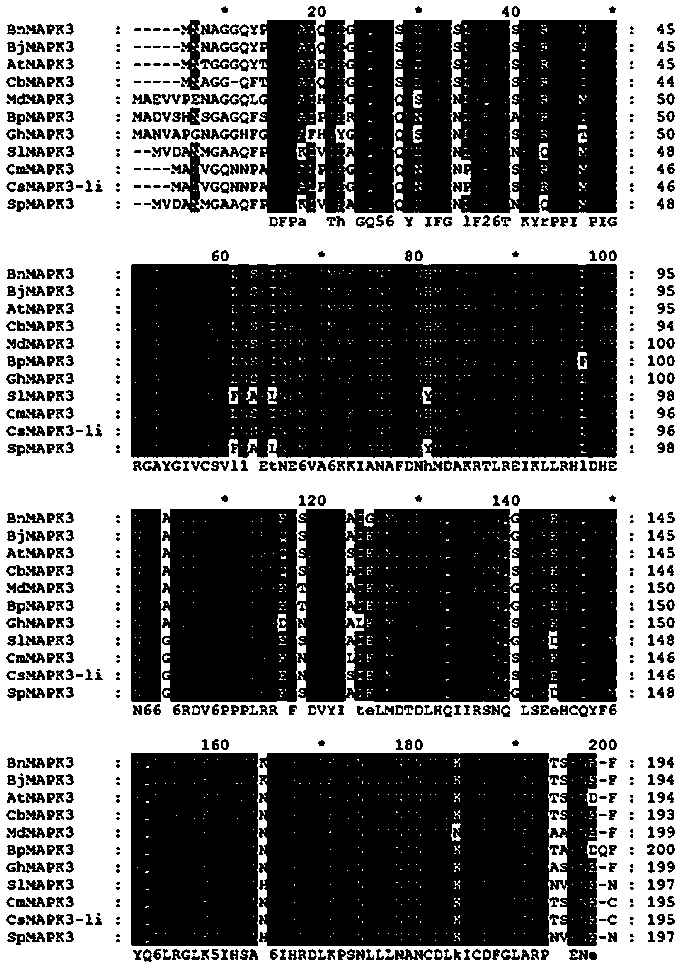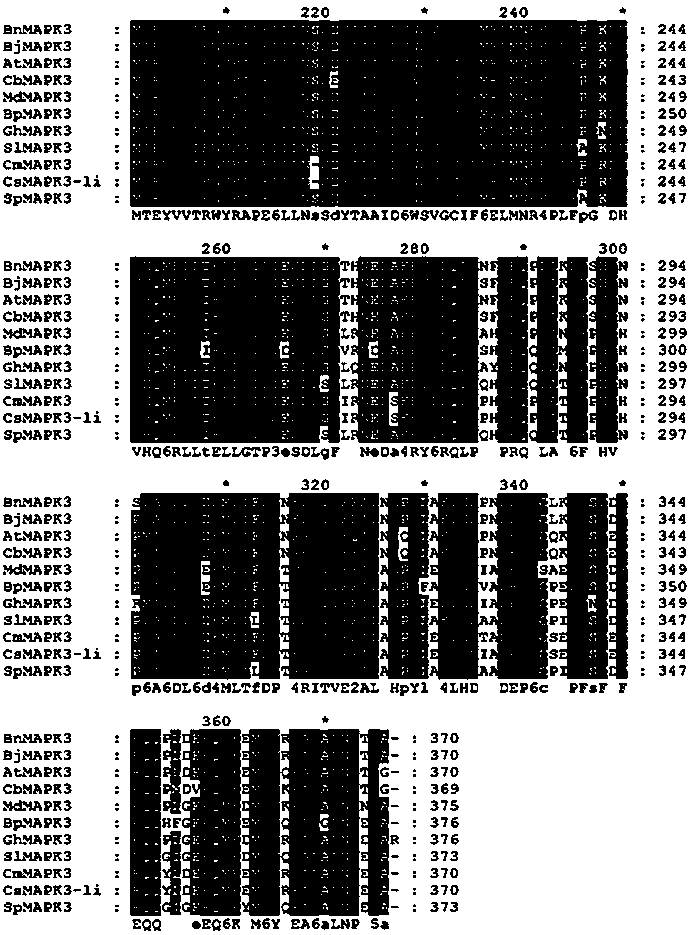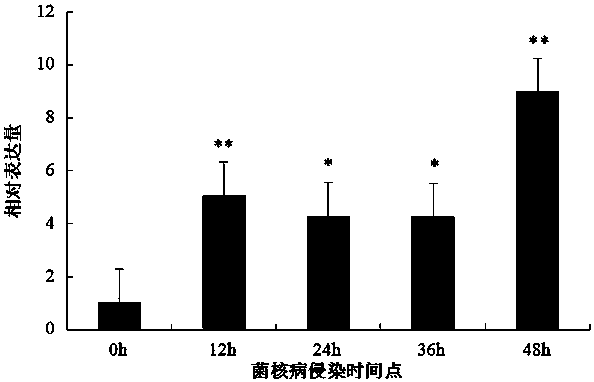Brassica napus gene bnmpk3 and its application in resistance to Sclerotinia sclerotiorum
A rapeseed sclerotinia and gene technology, which is applied in the application, genetic engineering, plant genetic improvement and other directions to achieve the effect of fast speed, simple operation and high efficiency
- Summary
- Abstract
- Description
- Claims
- Application Information
AI Technical Summary
Problems solved by technology
Method used
Image
Examples
Embodiment 1
[0036] Example 1: BnMPK3 gene cloning
[0037] (1) BnMPK3 Isolation and cloning of genes
[0038] The variety of Brassica napus Zhongshuang 9 (purchased from the Institute of Plant Oil Plants, Chinese Academy of Agricultural Sciences) was used as the experimental material. The growth conditions were: temperature 20 ± 2°C; humidity 60-90%; photoperiod 8 h per day 16 h dark; light intensity 44 μmol m –2 the s –1 .
[0039] Extraction of total RNA from rapeseed leaves and synthesis of cDNA used UNIQ-10 column Trizol kit (purchased from Shanghai Yingjun Biotechnology Co., Ltd.), and DNase Ⅰ (Bao Bioengineering (Dalian) Co., Ltd.) was used to remove the mixed For a small amount of DNA, the integrity of the total RNA was checked by 1% agarose gel electrophoresis. The cDNA was synthesized according to the operating instructions of the MMLV Reverse Transcriptase Kit (Promega (Beijing) Biotechnology Co., Ltd.), and 50 μmol / LOligo(dT)18 (Thermo Fisher Scientific) was used as the ...
Embodiment 2
[0044] Example 2: BnMPK3 Response to Sclerotinia
[0045] (1) Treatment of Sclerotinia
[0046] Sclerotinia sclerotiorum pathogen Sclerotinia sclerotiorum (isolated from Zhongshuang No. 9 variety of Brassica napus (purchased from the Plant Oil Institute of Chinese Academy of Agricultural Sciences) on the third leaf of rapeseed seedlings (at the four-leaf one-heart stage) was activated in the laboratory ) inoculation treatment, the plants were cultured at 23°C for 4-5 days before treatment, and then the leaves were kept in a dark environment for 24 hours. Then inoculate with mycelium blocks of Sclerotinia sclerotiorum, and control with sterile medium blocks. Samples were taken at 0 h, 12 h, 24 h, 36 h, and 48 h after inoculation.
[0047] (2) Extraction of Brassica napus RNA
[0048] The total RNA of the leaves after 0h, 12h, 24h, 36h, and 48h of S. sclerotiorum treatment in step 1 was extracted by plant Trizol (Shanghai Handsome Biotechnology Co., Ltd.).
[0049] (3) Real...
Embodiment 3
[0063] Example 3: Overexpression BnMPK3 Obtaining of Transgenic Rapeseed Plants
[0064] (1) Plant overexpression vector construction
[0065] Primers were designed using Primer Premier 5.0 software according to the CaMV 35S sequence (Gene ID: AJ007626) published on NCBI
[0066] 5′-GAATTCTTAATTAAGAGCTCGCATGCC-3′ and
[0067] 5'-GGTACCGTCCCCGTGTTTCTCCAA-3', the CaMV 35S fragment was amplified from the pEGAD vector (purchased from Treasure Bioengineering (Dalian) Co. Technology Co., Ltd.) EcoRI / KpnI restriction sites; at the same time, use Primer Premier 5.0 software to design primers according to the CaMVNos sequence published on NCBI (Gene ID: AJ007624)
[0068] 5′- GGATCCGAATTTCCCCGATCGTTCAA′-3′ and
[0069] 5′-AAGCTTGATCTAGTAACATAGATGACACCGC-3′, the CaMVNos fragment was amplified from the pEGAD vector by PCR and ligated into the pCAMBIA1300 vector Bam HI / Hin dIII restriction site, the pCAMBIA1300-35S-Nos vector is obtained. Endonuclease EcoRI, KpnI, Bam HI and ...
PUM
 Login to View More
Login to View More Abstract
Description
Claims
Application Information
 Login to View More
Login to View More - R&D
- Intellectual Property
- Life Sciences
- Materials
- Tech Scout
- Unparalleled Data Quality
- Higher Quality Content
- 60% Fewer Hallucinations
Browse by: Latest US Patents, China's latest patents, Technical Efficacy Thesaurus, Application Domain, Technology Topic, Popular Technical Reports.
© 2025 PatSnap. All rights reserved.Legal|Privacy policy|Modern Slavery Act Transparency Statement|Sitemap|About US| Contact US: help@patsnap.com



